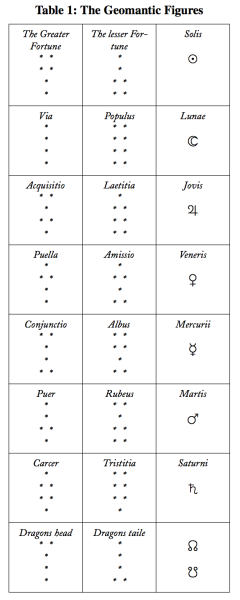This is an old revision of the document!
Geomancy Notes
European/Renaissance Geomancy
Geomancy is an Art of Divination, wherby the judgement may be rendred by lot, or destiny, to every question of everything whatsoever, but the Art hereof consisteth especially in certain points whereof certain figures are deducted according to the reason or rule of equality or inequality, likeness or unlikeness –Henry Cornelius AGRIPPA
“Geomancy” is derived from the Latin “geomantia,” which in turn is derived from the Greek for “divination by earth.” The Arabic name for geomancy, “'ilm al-raml,” means “the science of the sand.” In its original form, the geomantic figure was created by making lines of random numbers of dots in the sand, hence the name. Medieval European writers agreed that it was also acceptable to draw the dots on a piece of parchment or paper. In keeping with the Arabic origin of geomancy, most writers recommend making the dots from right to left, the direction in which Arabic is written. From the dots or points, the geomancer draws a series of figures which are arranged into the geomantic tableau. There are sixteen possible figures consisting of single or pairs of points. Each figure has a name, associations with the elements, planets, etc., and good or bad qualities. Interpretation depends on the meanings of the figures in particular locations in the tableau, and owes a great deal to the practice of medieval astrology. Unlike astrology, however, geomancy requires no instruments or complex calculations. https://www.princeton.edu/~ezb/geomancy/geostep.html
Geomantic Figures
Tibetan Geomancy (sa-bshad/ sa-dpyad/ sa-che)
- Sa-che (earth observations)
[un]related
- traditional geomantic/earth divination, seismography (Agrippa: divination by earth movements), pyromancy, aeromancy

